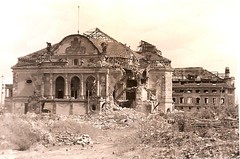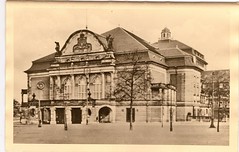Here’s the same scene taken some time after the bombing. My dad bought three cameras at an Army post exchange–including a Leica and a twin-lens reflex camera–and took many scenes of Kassel in 1946.
At first seeing this picture in a stack of old photos, we supposed that my dad took it. But looking again now, the picture and others that almost exactly reproduce the perspectives seen in a series of prewar postcards seem to have been done commercially. At least that’s my guess, since they appear to printed on postcard stock (though without credits). In short then, the photographer or photographers who documented prewar Kassel returned to the scenes they had shot earlier for the “after” view.
This scene speaks for itself. I’ve put up a (still unorganized) colllection of similar views on Flickr.
Technorati Tags: world war ii


